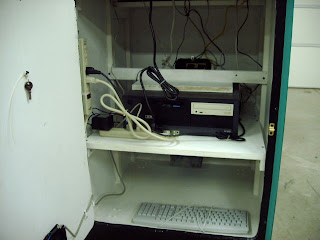Ok, Its been awhile since I posted. The job that pays me to be there required that I be there.
(Why cant they just mail me my check?)
I promised earlier that I would post how I hacked a cheap Power Strip to get my Switched Power Strip.
I picked up a cheap power switch from
Walmart. This power strip is cheap because it is not surge protected. This strip has a breaker switch mounted to it. This is really not necessary, but I left it on this strip. On the strip I hacked for The Rage, I removed the breaker and mounted the relay in the hole where the breaker was mounted.
This strip had plenty of room behind the breaker, so I decided to leave it.
The relay has a 12
VDC coil, and it's one normally open contact is rated for 10 amps and 250 VAC.
I found it on the Internet, bought 5 of them. The way it is shaped makes it perfect for this project.

I removed the six screws in the back of the power strip and gained easy access to it's insides.
See the black wire is soldered to the breaker switch, this is the wire I will cut and solder to the relay.

I then pulled the cable back and flipped the strip back over. Using the relay as a guide, I marked each corner.

Then using a straight edge, I "connected the dots" to give me a cutting pattern the same size as the relay.

I then used my soldering gun, with a cutting tip, to cut out the hole.

And here is the hole cut out. The soldering gun left a rough cut, but that's OK.

Next I inserted the relay into the hole. I put the connection tabs in first.
The hole was a little bit too big, you can see a space in front of the relay, but that's OK, I will fill in the gap with silicone caulking.
I then cut the black wire and trimmed both ends.

The relay contact tabs had a small hole in each. I drilled these holes bigger so I could stick the black wires into the tabs. I then bent the wires around the tabs, and soldered them.
You will need a hot soldering iron to do this, these connections need good solder joints.
I then soldered two wires to the relay's coil contact tabs.
I used speaker wire on The Rage, but I was out so I used some single conductor wire I had laying around. I twisted the wires together and put small sections of heat shrink tubing to keep them together. I put heat shrink over the coil tabs to insulate them.

I then pushed the coil wires through the gap in front of the relay. I positioned the green wire in the center of the relay, the white wire to the top side of it, made sure all the outlet buss bars were properly placed, then I put the cover back on the strip.
I then soldered the coil wires to a plug I will be using to plug this switched strip into my computer.
I then filled in the gap around the relay with silicone caulking, put a plastic wire tie around the body of the relay to hold the coil wires in place.

I tested the strip by plugging it into a wall outlet (None of my house circuit breakers tripped, so thats a good sign.)
I then connected the coil plug to a 12 volt power supply. (The relay clicked, another good sign.)
I then plugged my waffle iron into the power strip. I applied 12 volts, the waffle iron came on, I removed the 12 volts, waffle iron went off. The waffle iron is rated at 650 watts, so I figured it was an excellent test load for this strip. I don't think the total load will be that high on this strip when it is in the arcade.
And this my friends, is how I hacked a poor defenseless cheap
Walmart power strip to do a lifetime of servitude as a arcade machine part.
-----------------------



























